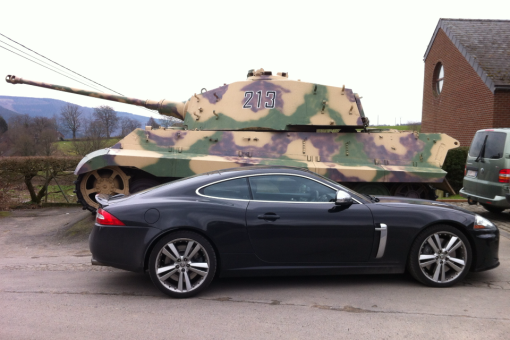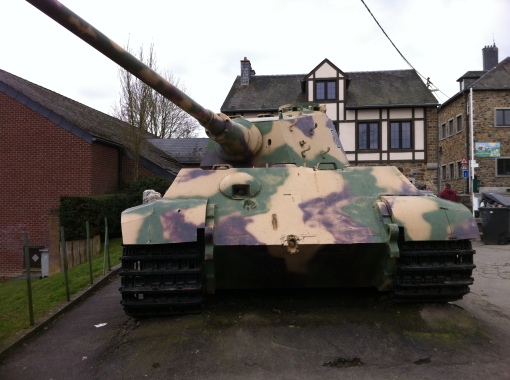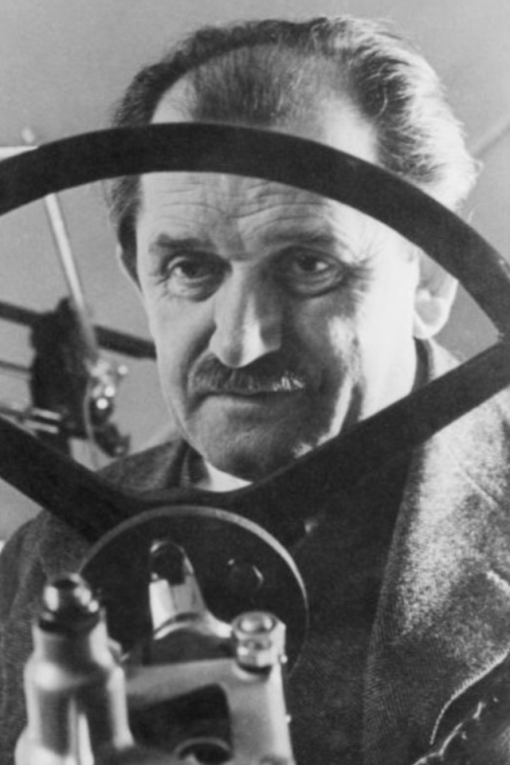A few miles west of the Spa circuit is the picturesque village of La Gleize. In the tiny village square, by the church high up on a hill sits a striking piece of Porsche engineering. The 70 ton King Tiger tank rests in the village where it ground to a halt nearly 70 years ago. When Hitler launched his final offensive in the West, known to the Americans as the Battle of the Bulge, the Tiger formed part of an SS battle group under the command of Nazi poster boy Joachim Pieper. The offensive was a failure and La Gleize was as far West as Pieper got. His battle group ran out of petrol and had to abandon all their vehicles. After the war scrap men cleared them all away but the Tiger was saved by the village inn keeper in exchange for a case of wine.
When I visited the Porsche Museum in Stuttgart it was astonishing that no where was the War, or indeed Nazi Germany, mentioned. Whilst Ferdinand Porsche’s role in developing the Volkswagen Beetle and the Silver Arrows racing cars was highlighted nothing was said of the driving force behind those projects, Adolf Hitler himself. Similarly no mention was made of Porsche’s significant design work for the Nazi war machine. The King Tiger at La Gleize is as much a Porsche as the Beetle.
In addition to his design work for the military Ferdinand Porsche also managed the Wolfsburg Volkswagen plant that by then was producing military vehicles. Forced and slave labour were widely used, something that led to Porsche’s imprisonment as a war criminal by the French at the end of the War. Again there was no mention of this at the Porsche Museum.
Even after the War Porsche as a company made some questionable decisions. One was to employ Joachim Pieper in a sales capacity in 1957. This was particularly questionable given Pieper had just been released from prison having served 11 years of a life sentence (which itself was a commuted death sentence) for the murder by his men of 86 US prisoners of war at Malmedy during the Battle of the Bulge. This was not an isolated incident. He and his men had previously established a brutal reputation for taking no prisoners and massacring civilians in Russia and in Italy. In the Ardennes they were responsible for killing at least 100 POWs (including 17 African Americans tortured to death) and several hundred civilians in towns such as Stavelot.
At the time they chose to employ him Pieper was not an obscure low level Nazi, he was an infamous war criminal. Furthermore he was widely known in Germany as Himmler’s former adjutant, a Knights Cross holder and the youngest Colonel in the SS. This was a man who by his own admission had visited concentration camps and witnessed the execution of Jews and the disabled without any moral qualms. What were Porsche thinking?
Pieper’s time with Porsche was brief. Unbelievably they had put him in charge of sales to America. When veterans organisations found out there was a public outcry and sales in the US suffered. Pieper was quietly sacked, but with compensation, in 1960.
It is inevitable that companies such as Porsche would have become involved in the dark side of German life under the Nazis. What is unforgivable is the denial demonstrated by Porsche at its Museum and generally. By contrast Mercedes Benz at their Museum (also in Stuttgart) pull no punches when describing their role under the Nazis. Their shame and embarrassment when talking about their use of slave labour and their role in equipping Hitler’s war machine, seem genuine. Porsche could learn something from them.



